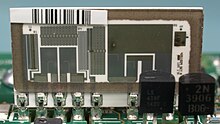Laser trimming is the manufacturing process of using a laser to adjust the operating parameters of an electronic circuit.

One of the most common applications uses a laser to burn away small portions of resistors, raising their resistance value. The burning operation can be conducted while the circuit is being tested by automatic test equipment, leading to optimum final values for the resistor(s) in the circuit.
The resistance value of a film resistor is defined by its geometric dimensions (length, width, height) and the resistor material. A lateral cut in the resistor material by the laser narrows or lengthens the current flow path and increases the resistance value. The same effect is obtained whether the laser changes a thick-film or a thin-film resistor on a ceramic substrate or an surface-mount resistor. The surface-mount resistor is produced with the same technology and may be laser trimmed as well.
Trimmable chip capacitors are built up as multilayer plate capacitors. Vaporizing part of the top layer with a laser decreases the capacitance by reducing the area of the top electrode.
Passive trim is the adjustment of a resistor to a given value. If the trimming adjusts the whole circuit output such as output voltage, frequency, or switching threshold, this is called active trim. During the trim process, the corresponding parameter is measured continuously and compared to the programmed nominal value. The laser stops automatically when the value reaches the nominal value.